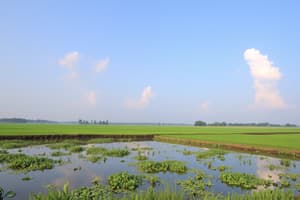Podcast
Questions and Answers
What does pollution primarily arise from?
What does pollution primarily arise from?
- Animal behavior and migration patterns
- Natural disasters
- Climate change and global warming
- Human activities that introduce unwanted substances (correct)
Which of the following defines a toxic effect?
Which of the following defines a toxic effect?
- It does not vary with different organisms
- It can be acute or chronic, based on the dosage pattern (correct)
- Only a single dose can cause long-term harm
- It is determined solely by the type of substance
What does the term 'Carcinogenic' refer to?
What does the term 'Carcinogenic' refer to?
- A cumulative effect that increases cancer risk over time (correct)
- The capacity to clean pollutants from the environment
- The measure of a substance's tastiness
- The immediate toxicity of a substance
What is the primary goal of pollution prevention (P2)?
What is the primary goal of pollution prevention (P2)?
How is a threshold for toxicity typically assigned?
How is a threshold for toxicity typically assigned?
What does the variable $H$ represent in the dispersion equation?
What does the variable $H$ represent in the dispersion equation?
How is the additional contribution to stack height, Δh, affected by the stack flow velocity?
How is the additional contribution to stack height, Δh, affected by the stack flow velocity?
What factors contribute to the calculation of Δh according to the provided equation?
What factors contribute to the calculation of Δh according to the provided equation?
In the dispersion equation, what does the variable $
u$ represent?
In the dispersion equation, what does the variable $ u$ represent?
If the electrical efficiency of the generator is 40%, what does this imply about the relationship between output power and fuel input?
If the electrical efficiency of the generator is 40%, what does this imply about the relationship between output power and fuel input?
What type of pollutants are PCBs classified as?
What type of pollutants are PCBs classified as?
Which year was the use of PCBs banned in the USA?
Which year was the use of PCBs banned in the USA?
What is a key feature of PFAS that distinguishes them from other chemicals?
What is a key feature of PFAS that distinguishes them from other chemicals?
What is the primary use of PCBs in industrial applications?
What is the primary use of PCBs in industrial applications?
Which heavy metals have been identified as contaminants at the Nitrastur site?
Which heavy metals have been identified as contaminants at the Nitrastur site?
Why are PFAS commonly referred to as 'forever chemicals'?
Why are PFAS commonly referred to as 'forever chemicals'?
In which year did the international ban on PCBs come into effect?
In which year did the international ban on PCBs come into effect?
What is the main environmental concern associated with the Nitrastur site?
What is the main environmental concern associated with the Nitrastur site?
What type of air pollutants are emitted directly from sources without undergoing any transformation?
What type of air pollutants are emitted directly from sources without undergoing any transformation?
Which of the following is a primary pollutant that can be emitted from vehicles?
Which of the following is a primary pollutant that can be emitted from vehicles?
Which parameter is commonly monitored as an air pollutant and can exist as particulate matter?
Which parameter is commonly monitored as an air pollutant and can exist as particulate matter?
What can contribute to the occurrence of harmful algal blooms in coastal areas?
What can contribute to the occurrence of harmful algal blooms in coastal areas?
What distinguishes secondary pollutants from primary pollutants?
What distinguishes secondary pollutants from primary pollutants?
Which substance is categorized as a carcinogenic air pollutant?
Which substance is categorized as a carcinogenic air pollutant?
Which element was primarily restricted in Venice to reduce eutrophication?
Which element was primarily restricted in Venice to reduce eutrophication?
What defines an aquifer?
What defines an aquifer?
Which of the following greenhouse gases is NOT considered a pollutant?
Which of the following greenhouse gases is NOT considered a pollutant?
What happens when water is pumped from a well faster than it is replenished?
What happens when water is pumped from a well faster than it is replenished?
What type of air pollutant does not exist in a solid or liquid form?
What type of air pollutant does not exist in a solid or liquid form?
What is the main health concern associated with air pollutants?
What is the main health concern associated with air pollutants?
Which type of rock can function effectively as an aquifer?
Which type of rock can function effectively as an aquifer?
What effect does pumping water create around a well?
What effect does pumping water create around a well?
Which of the following can be a source of cyanotoxins in freshwater?
Which of the following can be a source of cyanotoxins in freshwater?
What is one consequence of eutrophication in aquatic environments?
What is one consequence of eutrophication in aquatic environments?
Which of the following PFAS have been phased out of production in the United States?
Which of the following PFAS have been phased out of production in the United States?
What year did the largest US manufacturer completely stop PFOA/PFOS production?
What year did the largest US manufacturer completely stop PFOA/PFOS production?
What is the purpose of the PFOA Stewardship Program launched in 2006?
What is the purpose of the PFOA Stewardship Program launched in 2006?
Which of these methods expresses pollutant concentrations in the air phase?
Which of these methods expresses pollutant concentrations in the air phase?
What is the molecular weight equivalent to?
What is the molecular weight equivalent to?
How are pollutant concentrations in liquid phase commonly expressed?
How are pollutant concentrations in liquid phase commonly expressed?
What numerical value is Avogadro's number represented by?
What numerical value is Avogadro's number represented by?
Which units can describe pollutant concentrations when measuring mass per unit volume?
Which units can describe pollutant concentrations when measuring mass per unit volume?
Flashcards
Environmental Pollution
Environmental Pollution
Substances released from human activities that negatively impact air, land, and water, causing harm to the environment and living organisms.
Toxicity
Toxicity
The degree to which a substance can harm an organism.
Acute toxicity
Acute toxicity
A large dose of a substance that causes harm quickly.
Chronic toxicity
Chronic toxicity
Signup and view all the flashcards
Pollution prevention
Pollution prevention
Signup and view all the flashcards
Air Pollutants
Air Pollutants
Signup and view all the flashcards
Primary Pollutants
Primary Pollutants
Signup and view all the flashcards
Secondary Pollutants
Secondary Pollutants
Signup and view all the flashcards
Particulate Matter (PM)
Particulate Matter (PM)
Signup and view all the flashcards
Greenhouse Gases (GHGs)
Greenhouse Gases (GHGs)
Signup and view all the flashcards
Carbon Monoxide (CO)
Carbon Monoxide (CO)
Signup and view all the flashcards
Tropospheric Ozone (O3)
Tropospheric Ozone (O3)
Signup and view all the flashcards
Volatile Organic Compounds (VOCs)
Volatile Organic Compounds (VOCs)
Signup and view all the flashcards
What are Harmful Algal Blooms (HABs)?
What are Harmful Algal Blooms (HABs)?
Signup and view all the flashcards
What causes HABs in coastal areas?
What causes HABs in coastal areas?
Signup and view all the flashcards
What causes HABs in freshwater?
What causes HABs in freshwater?
Signup and view all the flashcards
What is Eutrophication?
What is Eutrophication?
Signup and view all the flashcards
What happened with eutrophication in the Venice Lagoon?
What happened with eutrophication in the Venice Lagoon?
Signup and view all the flashcards
What is an aquifer?
What is an aquifer?
Signup and view all the flashcards
What characteristics must an aquifer have?
What characteristics must an aquifer have?
Signup and view all the flashcards
What happens when water is pumped from a well faster than it replenishes?
What happens when water is pumped from a well faster than it replenishes?
Signup and view all the flashcards
Dispersion Equation
Dispersion Equation
Signup and view all the flashcards
Effective Stack Height (h)
Effective Stack Height (h)
Signup and view all the flashcards
Plume Rise (Δh)
Plume Rise (Δh)
Signup and view all the flashcards
Stack Flow Velocity (uS)
Stack Flow Velocity (uS)
Signup and view all the flashcards
Stack Diameter (dS)
Stack Diameter (dS)
Signup and view all the flashcards
Nitrastur Site
Nitrastur Site
Signup and view all the flashcards
PCBs
PCBs
Signup and view all the flashcards
PFAS
PFAS
Signup and view all the flashcards
Organic Chlorine Compounds
Organic Chlorine Compounds
Signup and view all the flashcards
Toxic
Toxic
Signup and view all the flashcards
Point Source Pollution
Point Source Pollution
Signup and view all the flashcards
Non-Point Source Pollution
Non-Point Source Pollution
Signup and view all the flashcards
ppmV or ppbV
ppmV or ppbV
Signup and view all the flashcards
Partial Pressure
Partial Pressure
Signup and view all the flashcards
Mass per Volume Concentration in Air
Mass per Volume Concentration in Air
Signup and view all the flashcards
Molar Concentration in Liquid
Molar Concentration in Liquid
Signup and view all the flashcards
Mass per Volume Concentration in Liquid
Mass per Volume Concentration in Liquid
Signup and view all the flashcards
Sorption
Sorption
Signup and view all the flashcards
Sorption Isotherm
Sorption Isotherm
Signup and view all the flashcards
Volatilization
Volatilization
Signup and view all the flashcards




